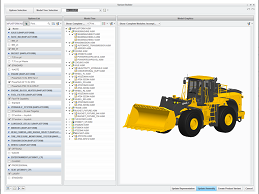 Creo Options Modeler is a dedicated app for creating ad validating modular product assemblies, regardless of the complexity of the assembly. It helps you to deliver personalise products, which meet your customer's needs. Whether these are market based or regional based requirements, Creo Options Modeler can help you to deliver them.
Creo Options Modeler is a dedicated app for creating ad validating modular product assemblies, regardless of the complexity of the assembly. It helps you to deliver personalise products, which meet your customer's needs. Whether these are market based or regional based requirements, Creo Options Modeler can help you to deliver them.
Companies develop products with modular architects, using Creo Options Modeler, meaning that they can deliver competitive differentiation to market. At the same time, they are able to keep cost and complexity under control. When you combine Creo Options Modeler with Windchill, you can generate and validate precise 3D representations of product designs that are actually connects to the Bill of Material from the Windchill environment.
What can you do with Creo Options Modeler?
First of all, you can view and interact with all of the relevant information about the options in one integrated environment. You can look at the product architecture. You can look directly at the 3D models. You can even view and interact with the Bill of Materials, turning things on and off to see different representations of the product. You can instantly select various product modules from the module list and immediately see the results in 3D. Then, you can quickly move to a fully regenerated version of the product right then and there in the app. Finally, you can validate the product. You can look at it visually and say, do I get the product that looks like what I want. Then, you can go on to do a more in-depth analysis of the product by looking at interferences to validate the product further.
With Creo Options Modeler, you can add new product modules to your designs very quickly. This includes product modules that were never part of the original design. This can even be done without having to download an entire Bill of Materials or product structure from your Windchill environment. This all leads to a significant enhancement in productivity.
Benefits of using Creo Options Modeler
Some of the benefits of Creo Options Modeler are, of course, the faster design cycles. Giving the engineers the opportunity to create and validate product modules very early in the 3D design phase, can lead to a much quicker time to market. Typically, you can spend days, if not weeks, actually developing the product architecture, either in an Excel spreadsheet or in some other tool before they actually get into the CAD environment. With Creo Options Modeler, it's possible to streamline the time it takes for you to do this. The other aspect of Creo Options Modeler that has really improved are the errors associated with transferring data from one part of the organisation to the other. Engineers take data from the marketing team to understand how the product should be architected; product architects work with the engineers to make sure the right product modules go together. All these data transfers can create error in the process. By automating the creation of the product in one environment, it can actually reduce errors by keeping everything in one place. It gives the engineers, the marketers and the product architects one opportunity to develop the information they need and to deliver it.
With Creo Options Modeler, it gives you the opportunity to create and validate 3D product designs earlier in the design process, while also sharing this information across the entire company in a much more straightforward way. It uses the rich 3D content that you see right on the screen and can understand.
To find out more about Creo Options Modeler, take a look at our dedicated page.
Want to try out Creo Parametric, free for 30-days? Get a trial here:
